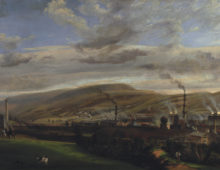What factors drove change in medical practice during the Age of Revolution? Enquiry focus 2
Anatomical research and Charles Bell
Suitable for students aged 14+
1. Watch
Students watch the Charles Bell video and write down any important points about the development of medical practice in the Age of Revolution.
If you are watching with the students, pause the video to help them reflect on the questions below as well as considering the types of questions the historians are asking, e.g How does Dr Ambrosio use the work of other historians in her answers?
Can students answer the following questions?
- How did Bell’s publications change people’s views of art and anatomy?
- How did Bell gain experience of surgery?
- How did Bell’s beliefs influence his work?
2. Test
Students can try this multiple choice quiz to see how much they have remembered from the video. Students working at home can save their answers as a PDF and email them to teachers.
3. Research
Charles Bell’s work is an interesting example of the way that art and science sometimes work together. Ask students to conduct some independent research on the life of Charles Bell and the influences on his work, focusing on his education in Edinburgh, his experiences during the Napoleonic wars and his use of print culture.
The following themes and objects provide more information on Bell and the three factors which influenced his work – education, war and print culture (these may also be factors which students can think about in other periods of medical history):
- Battlefield injuries illustrated by Charles Bell (these include some graphic images which some students may find upsetting)
- French revolutionary and Napoleonic wars
- The printing revolution
- The arts in the Age of Revolution
Students produce a mind map to organise their ideas.
4. Link
Developments in printing and the way that print culture was used to express ideas are especially important to the Age of Revolution. The historians in the video both highlight the influence of print culture in this period.
Students explore the following objects from the Revolutionary collection
For each object they make notes about how it:
- made printed material more accessible to ordinary people
- allowed the spread of new ideas to people across the world.
Both objects highlight the importance of print culture and technology to the period. Students could also look in more detail at objects which show the impact of war on wider society using objects from the following themes:
- War and the international order
- British riots and reforms
- The arts in the Age of Revolution
- Political revolution
5. Think
Students think about the rest of their studies on the History of Medicine. Are there any other examples they can think of (from any period) when there has been a link between art and medical science? Why do they think this happens? What is their opinion of works like that of Charles Bell?
In class this could be completed through paired or small group discussion. If students are studying at home they could be encouraged to use email or virtual chats to discuss their ideas.
6. Reflect
This enquiry focuses on influences on medical practice in the Age of Revolution and the causes of change. Students display their ideas using a Causation Diagram. They can structure the diagram in one of the ways shown here or think of their own idea. It should show how different factors (e.g. war and printing) had an influence on changing medical inventions and practices. Remind students to include important names, dates and medical vocabulary.
Students can continually update this diagram as they learn about different medical developments during the Age of Revolution. Encourage them to explore other objects from the Revolutionary Collection which interest them, to extend their knowledge and understanding of the period.
As students develop their diagrams of different causal factors, encourage them to consider different ways of showing links, highlighting key names and dates, and developing ideas for revision.
7. Extend
Students can use the Revolutionary collection to find another medical instrument or object that they are interested in. Make a series of annotated sketches in the style of Charles Bell to show its uses and development.
Students could be encouraged to look at other instances where art and medicine converge in different periods. In a whole class context, they could create a display of medical imagery.
Try the other enquiries in the series
What factors drove change in medical practice during the Age of Revolution?
Enquiry focus 1 – The kymograph
Enquiry focus 2 – Anatomical research and Charles Bell
Enquiry focus 3 – Surgical instruments
Enquiry focus 4 – Early anaesthetics
Consolidate your thinking – Drivers for change in medical practice during the Age of Revolution
Was change in medical practice revolutionary or evolutionary during the Age of Revolution?
Enquiry focus 1 – Vaccination
Enquiry focus 2 – The Old Operating Theatre
Enquiry focus 3 – Phrenology
Enquiry focus 4 – The stethoscope
Consolidate your thinking – Change in medical practice during the Age of Revolution


